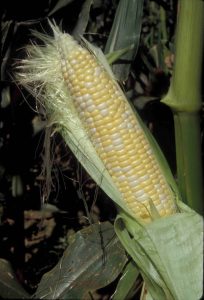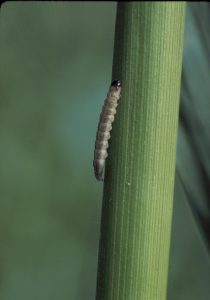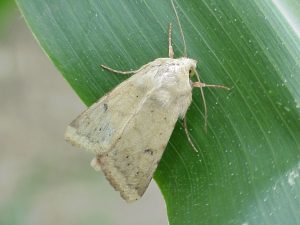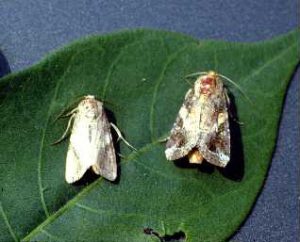Sweet Corn IPM Newsletter No. 10- September 3, 2021

Sweet Corn IPM Newsletter No. 10- September 3, 2021
Click on photos to enlarge.
CORN EARWORM THREATENS LATE SILKING CORN
All Sites Now on Protective Schedule for Fall Armyworm and Corn Earworm
SITUATION
The sweet corn season is winding down. Cooler nights should slow late corn maturity and insect flights. However, the recent tropical storm that passed through the state late in the week may have brought more moths from the south with it, which will become evident next week. Insect counts remained high enough this week to keep all farms on a regular spray schedule for corn earworm and/or fall armyworm on any fresh silking corn remaining.

European corn borer:
No fields were over the 15% control threshold for larval feeding activity this week. European corn borer moth trap counts were over the spray threshold for silking corn of 5/week at one site in Lewiston, which is under a spray schedule for earworm, so no additional spray for corn borer is warranted.

Corn earworm:
Pheromone trap moth captures were lower in some locations, but higher in others, as populations have become more evenly distributed across the state. A 4-day spray schedule was recommended for fresh silking corn in Cape Elizabeth, Dayton, New Gloucester, Oxford, and Wayne. A 5-day spray schedule was recommended for Bowdoinham and one Wells site. A 6-day spray interval was recommended for Auburn, Biddeford, Garland, Lewiston, Monmouth, Palmyra, Sabattus, and one Wells site. Continue protecting silking corn until five to seven days before harvest, or once silks are thoroughly dry and brown.

Fall armyworm:
Moths counts were lower at some sites this week, but remained high enough to warrant protection of silking corn at most locations. However, all sites are now on a recommended spray schedule for corn earworm, which should also provide protection against fall armyworm. Sites that were over threshold this week include: Auburn, Biddeford, Bowdoinham, Cape Elizabeth, Dayton, Garland, Monmouth, New Gloucester, Wayne, and Wells. Larval feeding damage has been found in younger fields, exceeding the spray threshold of 15% of plants showing injury in Cape Elizabeth and one Dayton site. Most fields are now in silk or nearly mature, but fields not yet in silk should be protected when feeding damage exceeds the threshold.

Western Bean Cutworm:
Most sites had no western bean cutworm in pheromone traps this week. Only one site in Oxford had three moths, which would trigger a spray recommendation in silking corn, but only if that field was not under a spray schedule for corn earworm.
Downy Mildew Alert for Squash and Pumpkins:
This fungus disease has recently been reported in Massachusetts and southern New Hampshire. The tropical storm may have brought spores northward to infect Maine fields. Any mature pumpkins and squash can be harvested and cured to avoid infections in the field. Fields that are not yet mature can be treated with preventative fungicides. Cucurbit downy mildew has become resistant to many fungicides used against it in the past. Newer products such as Ranman®, Previcure Flex® and Presidio® appear to still have good activity. For more information, including products and rates, consult the New England Vegetable Management Guide.
Sincerely,
David T. Handley
Vegetable and Small Fruit Specialist
Highmoor Farm Pest Management Unit
P.O. Box 179 17 Godfrey Drive
52 U.S. Route 202 Orono, ME 04473
Monmouth, ME 04259
207.933.2100 1.800.287.0279
| Location | CEW
Moths |
ECB
Moths |
FAW
Moths |
%Feeding
Damage |
Recommendations / Comments |
|---|---|---|---|---|---|
| Auburn | 2 | 0 | 3 | 6-day spray interval for silking corn | |
| Biddeford | 2 | 2 | 5 | 12% | 6-day spray interval for silking corn |
| Bowdoinham | 7 | 1 | 12 | 6% | 5-day spray interval for silking corn |
| Cape Elizabeth | 25 | 0 | 12 | 33% | 4-day spray interval for silking corn |
| Dayton I | 56 | 3 | 63 | 4-day spray interval for silking corn | |
| Dayton II | 23 | 0 | 41 | 15% | 4-day spray interval for silking corn |
| Garland | 3 | 0 | 12 | 6-day spray interval for silking corn | |
| Lewiston | 3 | 6 | 0 | 6-day spray interval for silking corn | |
| Monmouth | 2 | 2 | 34 | 6-day spray interval for silking corn | |
| New Gloucester | 16 | 0 | 3 | 3% | 4-day spray interval for silking corn |
| Oxford | 8 | 0 | 1 | 4-day spray interval for silking corn | |
| Palmyra | 3 | 0 | 0 | 6-day spray interval for silking corn | |
| Sabattus | 3 | 2 | 1 | 6-day spray interval for silking corn | |
| Wayne | 15 | 1 | 5 | 4-day spray interval for silking corn | |
| Wells I | 3 | 0 | 4 | 6-day spray interval for silking corn | |
| Wells II | 7 | 0 | 29 | 5-day spray interval for silking corn |
CEW: Corn earworm (Only fresh silking corn should be sprayed for this insect.)
ECB: European corn borer
FAW: Fall armyworm
| Moths caught per week | Moths caught per night | Spray interval |
|---|---|---|
| 0.0 to 1.4 | 0.0 to 0.2 | No spray |
| 1.5 to 3.5 | 0.3 to 0.5 | Spray every 6 days |
| 3.6 to 7.0 | 0.6 to 1.0 | Spray every 5 days |
| 7.1 to 91 | 1.1 to 13.0 | Spray every 4 days |
| More than 91 | More than 13 | Spray every 3 days |
Thresholds apply only to corn with exposed fresh silk. Lengthen spray intervals by one day if maximum daily temperature is less than 80°F.
European Corn Borer Thresholds
Whorl stage: 30% or more of plants scouted show injury.
Pre-tassel-silk: 15% or more of plants scouted show injury.
Silk: 5 or more moths caught in pheromone traps in one week.
IPM Web Pages:
Where brand names or company names are used, it is for the reader’s information. No endorsement is implied nor is any discrimination intended against other products with similar ingredients. Always consult product labels for rates, application instructions and safety precautions. Users of these products assume all associated risks.
The University of Maine is an equal opportunity/affirmative action institution.
